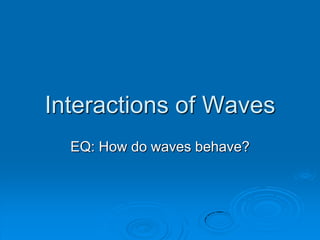
Wave Interactions Explained
- 1. Interactions of Waves EQ: How do waves behave?
- 2. Wave Interference Two different material objects can never occupy the same space at the same time. Because mechanical waves are not matter but rather are displacements of matter, two waves can occupy the same space at the same time. The combination of two overlapping waves is called superposition. Superposition Principle : When two waves interfere, the resulting displacement of the medium at any location is the algebraic sum of the displacements of the individual waves at that same location. Works for both longitudinal waves and for transverse waves
- 3. Wave Interference To determine the amount of interference: Simplyalign the waves in time and add the amplitudes Amplitudes can be either positive (above equilibrium) or negative (below equilibrium)
- 4. Wave Interference Constructive Interference: If the amplitudes are of the same sign, the wave is reinforced and grows bigger Destructive Interference: If the amplitudes are of opposite sign, the wave is diminished and grows smaller
- 5. Wave Interference Constructive Transverse Longitudinal Destructive Transverse Longitudinal
- 6. Wave Interference Examples: Sound – creates beats • Constructive = Louder sound • Destructive = Softer or no sound Light • Constructive = Brighter Light; change in color • Destructive = Dark or no light Water • Constructive = Larger crests • Destructive = No visible wave
- 7. Wave Interference Examples: Interference of two circular waves. Absolute value The colors seen in a soap bubble or an oil film snapshots of the (real- on water are a common example of interference. valued, scalar) wave field. Light reflecting off the front and back surfaces of Wavelength increasing from the thin soap film interferes, resulting in different top to bottom, distance colors being enhanced. between wave centers increasing from left to right. The dark regions indicate destructive interference.
- 8. Wave Reflection Reflection-A wave will bounce off an object Wave reflection from surfaces depends on the characteristics of the surface Smooth hard surfaces reflect best Rough soft surfaces reflect poorly Energy not reflected is absorbed or transmitted through the material
- 9. Wave Reflection Law of Reflection- A wave bounces off at the same angle it hits. (angle measured with respect to the normalline Think of arrows pointing in the direction of the wave motion Angles Equal
- 10. Wave Reflection What happens to the motion of a wave when it reaches a boundary? At a free boundary, waves are reflected. At a fixed boundary, waves are reflected and inverted.
- 11. Wave Reflection - Sound Echoes are produced when sound is reflected. An echo can only be heard by the human ear when the time interval b/w the echo and the original sound is greater than 0.1 s and the distance b/w the person and the reflecting surface is greater than 17 m. If smaller than 17 m, then called Reverberation.
- 12. Wave Reflection - Examples
- 15. Wave Refraction If there is a change in the characteristics of a medium, waves are bent This occurs because different parts of the wave front travel at different speeds Think of a marching around a curved track The inside people have to move more slowly than the outside people to keep the lines straight
- 17. Wave Refraction - Sound
- 19. Wave Reflection & Refraction The combination of reflection and refraction enables imaging Ultrasonic medical imaging Naval SONAR for detecting submarines Bats catch mosquitoes
- 20. Standing Waves A standing wave is produced when a wave that is traveling is reflected back upon itself. Appear to stand still There are two main parts to a standing wave: Antinodes – Areas of MAXIMUM AMPLITUDE Nodes – Areas of ZERO AMPLITUDE.
- 21. Standing Waves
- 22. Standing Waves
- 23. Natural Frequency Objects have ―natural‖ frequencies The frequency that they vibrate at when disturbed Based on their size and structure Guitar strings are an example
- 24. Resonance Reinforcing of an object’s natural frequency so that the amplitude increases quickly If you have ever been talking in a bathroom and notice that certain notes are very loud—that’s resonance: that loud note is the natural frequency of that room. Think about a swing on a playground - You go high when you pump the swing at its natural vibration frequency Resonance is how a soprano can break a glass with her voice.
- 25. Resonance Tacoma Bridge 7, 1940, one of the most famous incidents involving the collapse of a bridge occurred. The Tacoma Narrows Bridge (formerly the Tacoma Suspension Bridge) was a mile-long bridge on Route 16 in Washington State. The original bridge was built with faulty construction which yielded a potentially tragic situation when four months after its completion, the bridge collapsed in the face of what many recall as a light breeze. Fortunately, there were no cars on the bridge at the time of the collapse, hence no human lives lost. A dog walking on the bridge during the incident, did in fact lose his life as a result of the collapse – the light breeze caused the bridge to “resonate” until the amplitude became to great for the infrastructure
- 26. Wave Diffraction Diffraction- is when a wave spreads out after passing through an opening.
- 27. Intensity the energy per unit time per unit area perpendicular to the direction of wave propagation. Light – Brightness Sound – loudness